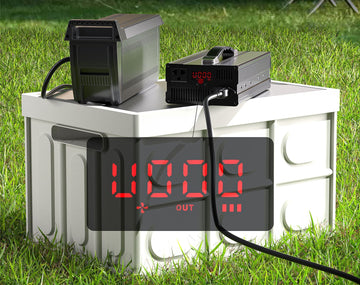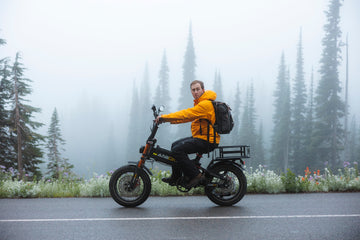When it comes to riding an electric bicycle, proper tire pressure is essential for optimal performance, safety, and overall riding experience. The right pressure will let your bike roll smoothly. If you don't inflate the tires, you'll see a serious drop in comfort. You will also experience a host of problems like difficulty braking, and the tires will wear down faster. Here is everything you should know about psi for bike tires.
The Basics of Bike Tire PSI
Maintaining proper tire pressure is a vital aspect of ensuring a smooth and puncture-free bike ride. By understanding the factors that influence tire pressure and learning how to accurately measure it, you can enhance your cycling experience and extend the longevity of your tires.
Understanding Tire Pressure for Different Bike Types
Different bike types require varying tire pressures to maximize performance and safety. Road bike tires, with their narrower design, necessitate higher air pressure ranging from 65 to 95 psi. On the other hand, mountain bike tires, built for rugged terrains, typically require lower pressures ranging from 15 to 25 psi. By considering your bike type and the recommended pressure range, you can ensure optimal performance and grip on various surfaces.
Factors to Consider
To determine the ideal tire pressure for your bike, it's crucial to take into account certain factors such as riding terrain and body weight. These factors can influence the appropriate pressure needed for a comfortable and efficient ride. For instance, if you weigh around 200 pounds, a tire pressure of approximately 120 psi may be suitable. However, it's always advisable to consult your bike manufacturer's recommendations, which are often indicated on the sidewall of the tire.
Ensuring Accuracy
To eliminate any doubts regarding tire pressure accuracy, it's recommended to use an accurate air pressure gauge. Local bike shops often have reliable gauges that can provide precise readings. By regularly checking and adjusting your tire pressure using a trusted gauge, you can maintain consistency and reliability in your rides.
Different Per Square Inch (PSI) for Bike Tire Pressure Explained
PSI for kids bike tires
For kids bike tires, the recommended PSI falls between 20 and 40. It is advisable to focus on a lower PSI for novice riders, as this provides increased stability and control. Regularly checking the tire pressure every two weeks and topping it up when close to the lower limit will ensure optimal performance and prevent discomfort during rides.
PSI for road bike tires
Road bikes demand a higher PSI, typically ranging from 80 to 130. The tire pressure on road bikes affects both performance and comfort, impacting factors such as rolling resistance and overall ride quality. To measure tire compression, place the bike on a smooth surface and measure the distance between the rim and the floor. If the distance is too low, inflating the tires to the recommended PSI will optimize performance.
PSI for mountain bike tires
Mountain bikes require a PSI range of 25 to 35, with slightly higher pressure on the rear wheel compared to the front. Fine-tuning the tire pressure within this range can be a matter of personal preference, considering factors such as terrain and riding style. Experimentation may be necessary to find the optimal PSI that provides the desired balance of grip and shock absorption.
Things to Consider When Adding Air Pressure to Your Ebike Tire
Riding Conditions and Terrain
Consider the type of terrain you typically ride on, whether it's smooth pavement, off-road trails, or a combination of both. The riding conditions and terrain should influence your tire pressure adjustments. For example, lower tire pressure can provide better traction and shock absorption on rough terrains, while higher tire pressure is ideal for smooth surfaces and reducing rolling resistance.
Rider Weight
Your weight as a rider directly affects the tire pressure required for optimal performance. Heavier riders may need higher tire pressure to prevent excessive sidewall flex and potential pinch flats, while lighter riders may benefit from slightly lower tire pressure for improved comfort and traction. Experiment with different pressures within the recommended range to find the sweet spot that suits your weight and riding style.
Personal Preference
Tire pressure can also be a matter of personal preference. Some riders prefer slightly higher or lower pressure depending on their desired riding characteristics. Higher pressure can provide a more responsive and efficient ride, while lower pressure can offer enhanced comfort and traction. It's important to find a balance that works for you and aligns with your riding preferences.
Regular Pressure Checks
Make it a habit to check your tire pressure regularly. Factors such as temperature, riding distance, and time can affect the air pressure in your tires. Use a reliable pressure gauge to measure the PSI accurately. If the pressure is below the recommended range, add air gradually in small increments, checking the pressure after each addition until you reach the desired level.
FAQs for Ebike Tire Pressure
Can you check the tire pressure without a gauge?
If you don't have a pressure gauge, you should press the tire between your thumb and index finger. If it feels firm, then the pressure is too high. Likewise, if the pressure is too low, you should fill up the tires. Another strategy is using the puddles. You should ride the bike through a puddle and then on dry land. If there's a long water trail, you should inflate the tires.
Why should you check the tire pressure of your bike?
Whether you have a road or a mountain bike, you should check the tire pressure. Many things can affect the gradual tire shifts like the weight of the rider and how long you ride. In cold weather, you have to fill in the tires often.
Is 45PSI too high?
Yes, 45 PSI is generally considered too high for an e-bike. Excessive pressure can compromise handling and lead to increased tire wear. It's important to follow the PSI recommendation provided by the manufacturer for your specific e-bike model.
What should the tire pressure be on a hot afternoon?
On a hot afternoon, it's advisable to set the tire pressure approximately four units above the recommended level. The heat can cause the air inside the tires to expand, and slightly higher pressure helps maintain the optimal riding performance.






